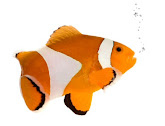Fish for the Cold Water Aquarium – the Oriental Weatherfish, Misgurnus anguillicaudatus & European Weatherfish
Weatherfishes are large and active, and adults should be given a tank of 20 gallons or more. They are also ideally suited to outdoor ponds and are finding increasing favor among koi and goldfish keepers. The aquarium’s lid and any spaces around filter intake tubes must be secured tightly, as these alert fellows are accomplished escape artists.In the wild, weatherfishes spend a good deal of time buried in the substrate, with just their heads protruding. In contrast to most other burrowing fish, they become quite bold in the aquarium and quickly abandon their secretive ways. Still, a soft substrate is appreciated, and it is quite amusing to see them burst forth from the sand when they detect food. I suggest Aqua Terra sand. If you do use gravel, be sure it is a smooth variety, such as walnut gravel, so that the delicate skin will not be damaged.Always hungry, weatherfishes spend a good deal of time foraging – and in doing so are likely to uproot growing plants. However, well-rooted aquarium plants should be included in the aquarium when possible, as the fish seem to favor resting among plant leaves and stems.Although weatherfishes get along quite handily without much aeration, their tank should be have a good aquarium filter as these ravenous feeders produce a good deal of waste.Temperature and Other Water ParametersThe European species is adapted to cool and cold climates, and does best if water temperatures are kept below 75F. Oriental weatherfishes are far more adaptable, and inhabit areas where the water temperatures range from 36 -86F. They become inactive when temperatures dip below 50F or so, and are best kept at 66-75F.Weatherfishes are undemanding as regards pH and water hardness, but do best at a pH of 7 or slightly below and in soft water.FeedingWeatherfish do a fine job of consuming food missed by tank-mates. Armed with sensory barbels, they miss little and will even root below gravel and rocks for food trapped there. However, they have quite large appetites and should by no means be expected to get by on leftovers.Both species do best when offered a variety of foods. Although primarily carnivorous, weatherfishes should also be given food preparations that contain some plant material, such as flake fish food and Tetra tablets. A variety of freeze dried fish food, such as bloodworms and krill, should also be offered.Free-living weatherfishes feed largely upon insects and other invertebrates, and captives do best when given ample live food. They particularly favor crushed crickets, blackworms, brine shrimp and small earthworms, and will take bits of fish and wild-caught insects as well. I have kept a number of individuals of both species for decades (see below) and attribute some of my success to a diet high in a variety of live foods.Social Grouping/Compatible SpeciesWeatherfishes seem quite social by nature, and often rest in physical contact with others of their kind. You may even see them “exploring” one another with their barbels. They are sturdy enough to be kept with fairly large fish, and do not bother smaller animals (however, they will consume fish eggs and, possibly, fry). I have successfully kept them with fairly aggressive animals such as American eels and African clawed frogs without incident.Captive LongevityAn Oriental weatherfish in my collection lived for 21 years. Longevities of 10-15 years are regularly reported.BreedingBreeding can be induced in both species by gradually lowering the water temperature to 60-65F while simultaneously dropping the water level to ½ the usual level and shortening the light cycle to 8 hours. After 2-4 weeks (longer periods may be required by fish from certain populations), water of approximately 10F warmer than ambient should be added to raise the water level back to normal. The temperature should be maintained at 72-75F and the light cycle increased to 14 hours.The greenish eggs are attached to plants and the substrate following a “mating dance” of sorts. The males, distinguishable by their slightly larger and triangularly shaped pectoral fins, fertilize the eggs externally. It is best to remove the eggs (or adults) for hatching, which occurs in 3-5 days. The fry readily accept Daphnia, newly hatched brine shrimp prod, chopped blackworms and other live foods, and there are reports that they will take flake fish food and finely chopped frozen bloodworms as well.MiscellaneousWeatherfishes are exceptionally responsive to food and take readily to hand feeding – they will even wiggle onto a palm held partially out of water for a favored treat. To encourage hand feeding, try using freeze-dried or fresh prawn.As mentioned in Part I of this article, I have encountered Oriental weatherfishes of 12-13 inches in food markets in two of NYC’s Chinese communities. The fish I found were in poor shape, but you may wish to keep an eye out for others in food markets – those I saw were much larger than pet trade animals, and would have made spectacular additions to any collection.Please be aware that weatherfishes, like eels, catfishes and other scale-less species, are sensitive to many fish medications. Be sure to read the label carefully



